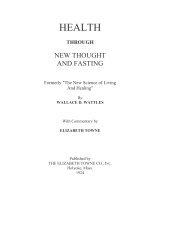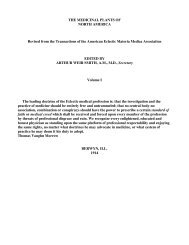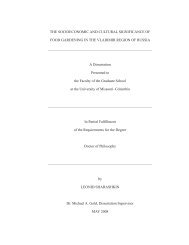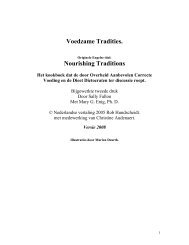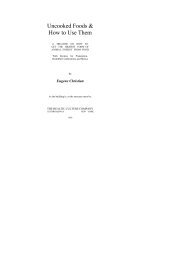FACTORS OF SOIL FORMATION - Midlands State University
FACTORS OF SOIL FORMATION - Midlands State University
FACTORS OF SOIL FORMATION - Midlands State University
Create successful ePaper yourself
Turn your PDF publications into a flip-book with our unique Google optimized e-Paper software.
system that are not universally recognized as soil properties. They are<br />
the following: soil climate (soil moisture, soil temperature, etc.), kind<br />
and number of soil organisms, and topography, or the shape of the<br />
surface of the soil system. These properties will be denoted by special<br />
symbols (cl' = climate, o' = organisms, r' = topography or relief),<br />
which are included in Eq. (1)<br />
F (cl', o', r', s l , s 2 , s 3 , • • • ) = 0 (2)<br />
There is no essential difference between Eqs. (1) and (2) except that<br />
some of the soil properties have been grouped together and given<br />
special symbols. The reason for doing so will become obvious at a<br />
later stage of our discussion. Emphasis should be placed on the fact<br />
that in Eq. (2) the soil system is defined or described by its own<br />
properties and nothing else. Moreover, soil is treated as a static<br />
system. No reference is made that the properties may change with<br />
time.<br />
Soil Formation.—The transformation of rock into soil is<br />
designated as soil formation. The rock may be gneiss, limestone,<br />
shale, sand, loess, peat, etc. To avoid too liberal an interpretation of<br />
the term "rock," soil scientists prefer to use the expression ''parent''<br />
material or "soil'' material. The relationship between parent material,<br />
soil formation, and soil may be conveniently expressed as follows:<br />
Parent material———————> Soil<br />
Soil formation<br />
The foregoing formulation introduces a new factor or variable into our<br />
discussion, namely, time. The states of the soil system vary with time,<br />
i.e., they are not stable. Suppose we consider a piece of granite that is<br />
brought to the surface of the earth. In the interior of the earth, the<br />
granite may have been in equilibrium with its immediate<br />
surroundings; but now, on the surface of the earth, it is in an entirely<br />
new environment, and the rock system is highly unstable. It is<br />
continuously changing its properties in a definite direction, namely,<br />
toward a new equilibrium state. When the final equilibrium state has<br />
been reached, the process of transformation, of soil formation, has<br />
been completed, and the rock has become a mature soil. It is<br />
customary to designate the intermediate, unstable states as immature<br />
soils. We may define the phases of soil formation as follows:<br />
Parent material————————> Soil (mature)<br />
Initial state Intermediate states Final state<br />
of system<br />
of system<br />
In this formulation, soil is treated as a dynamic system. Emphasis is<br />
placed on the changes of the properties of the soil as a function of<br />
time.<br />
It may be well to point out that the foregoing concept of soil<br />
formation is broader than that of a certain group of soil scientists who<br />
sharply distinguish between weathering and soil formation. The<br />
former process is said to be geologic and destructive, whereas the<br />
latter is pedologic and creative. In the present treatise, we adopt a<br />
more conservative viewpoint and consider weathering as one of the<br />
many processes of soil formation.<br />
Soil-forming Factors.—Agriculturists have long realized that<br />
many important properties of soils are inherited from the underlying<br />
rocks. Technical expressions like limestone soils or granitic soils are<br />
encountered in the oldest textbooks on agricultural subjects. They<br />
clearly convey the importance of parent material in soil formation.




